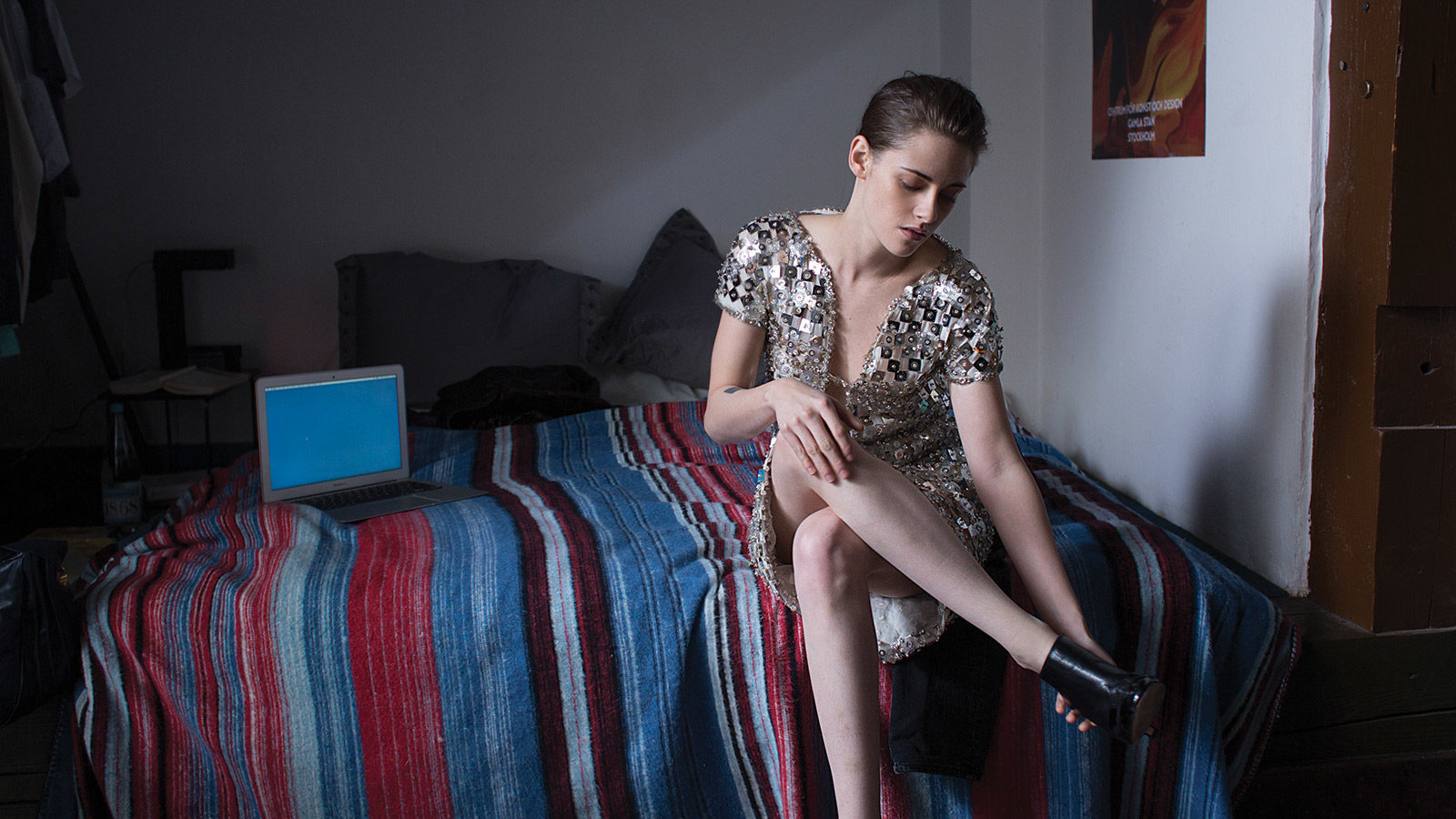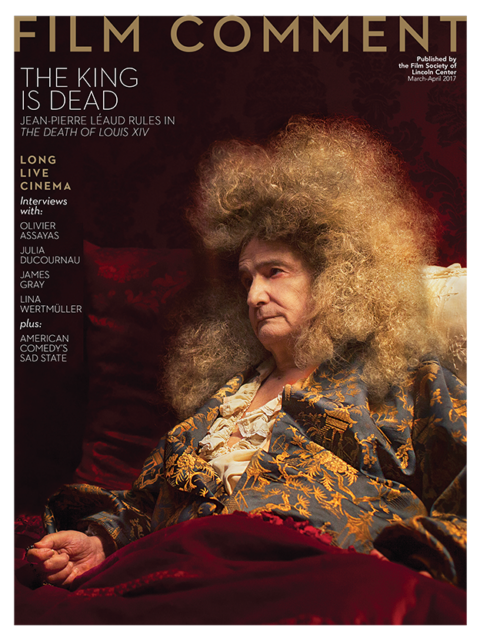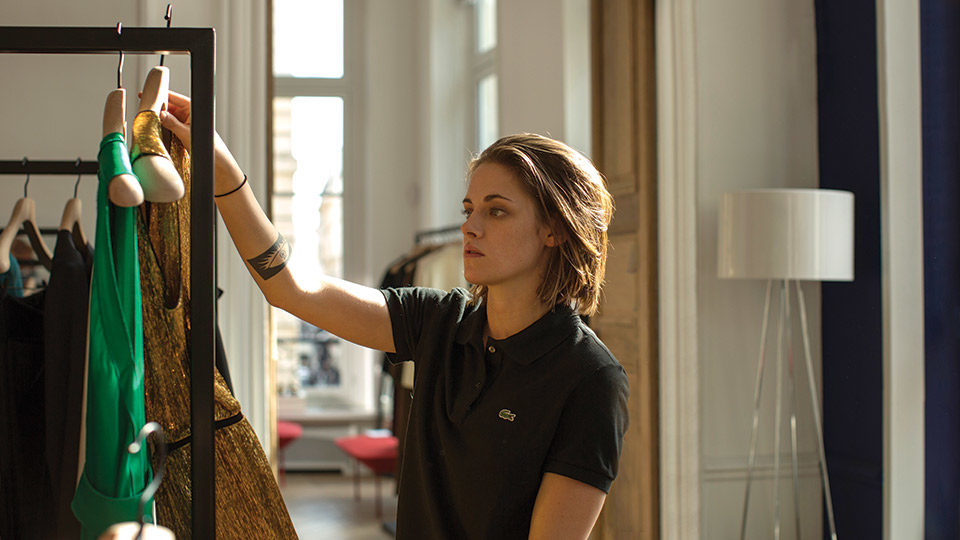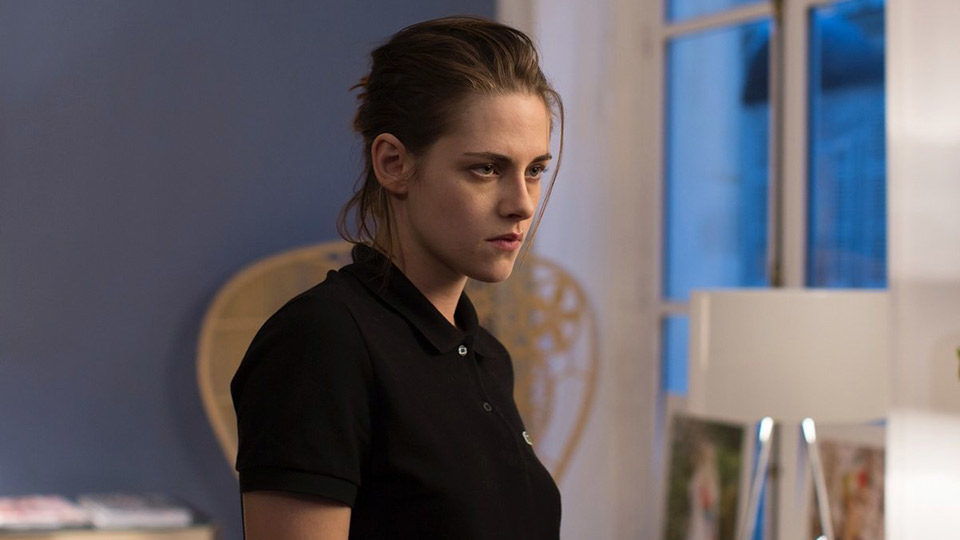By Jonathan Romney in the March-April 2017 Issue

The Material World
Olivier Assayas’s metaphysical drama searches for answers—and fresh questions—in a digital-spiritual realm
You might wonder how often Kristen Stewart’s acquaintances—seeing her nervously alert, fragile pallor—have said to her, “You look like you’ve seen a ghost.” In Olivier Assayas’s English-language film Personal Shopper, Stewart’s haunted look comes mesmerizingly into its own in a story about a young woman hoping to communicate with the beyond. Stewart plays Maureen, a young woman living in Paris and working for wealthy socialite Kyra (Nora von Waldstätten). Maureen’s job is to choose and buy the clothes that Kyra will wear at high-profile society functions; she is an artist of sorts in that she helps fabricate Kyra’s visible persona. But hers is also a thankless, impersonal task. She has permanent access to Kyra’s Paris apartment, but has next to no direct contact with her: she belongs to the army of unseen attendants who serve the new aristocrats of today’s global Versailles of the plutocracy and media.

From the March-April 2017 Issue
Also in this issue
In her private time, however, Maureen is committed to exploring another sphere entirely. Her twin brother Lewis, a psychic, has died of a heart condition that afflicts Maureen too; before passing away, he agreed that, if there is an afterlife, he would send her a sign. The film begins with Maureen spending the night in Lewis’s cavernous old house, now empty, waiting for such a communication. On her second visit, she sees a presence—a proper old-fashioned ghostly apparition that sends her running in terror. But the presence that really affects Maureen deeply—and unsettles us too, in a long sequence steeped in Hitchcockian tension—is the one that contacts her via cell phone while she’s traveling by train to London, toying with her through menacing text messages.
It’s a gamble typical of Assayas that this story operates in several different modes, and is set in worlds that appear quite incompatible. The ghost-story tradition of old dark houses and creaking floorboards hardly seems an obvious fit with the glossy sphere of glamorous nowness inhabited by Kyra. In fact, the narrative passes between three very different realms: the unseen world of the spiritual, l’au-delà—the beyond—as Assayas terms it in the interview below (conducted at Cannes 2016); the rarefied world of affluent appearance in which Maureen earns her living; and the concrete, mundane Paris that we intermittently see Maureen travel through, on her bike or by Metro.

Similarly, Personal Shopper is built around a disparity between the abstraction of the idea of contact with the dead and the quotidian familiarity of text messaging and Googling. That contrast is essential to a key idea in the film: that the realm of digital communication is to us what the supernatural was to past generations. We see the digital as mundane, domesticated, a power we can hold in our pockets in the form of phone apps. Yet the digital also enjoys a quasi-magical prestige: most of us don’t understand how it works, but we rely on it as an omnipresent force that can be conjured up at will, allowing us to summon oracles when required (Wikipedia), to communicate with distant beings as if gazing into a crystal ball (Skype), or indeed, to receive messages from unknown realms (as Maureen does, seriously entertaining the possibility that the texts are from her dead brother). Kyra herself is essentially an immaterial being—only briefly glimpsed in person, she mostly inhabits the space of the laptop screen, on a website where she’s pictured schmoozing with Karl Lagerfeld. The distant realm of reality that she inhabits is as fiercely defended by proscriptions as the afterlife: the transgression that Maureen commits, which engenders the peril familiar from a thriller narrative, is not an actual crime but the innocent yet expressly forbidden act of trying on Kyra’s shoes and clothes (although masturbating while wearing someone else’s frocks is no doubt taboo in any culture).
Assayas’s films often balance precariously between of-the-minute modernity—sometimes to the point of seeming merely zeitgeisty or chic—and a sense of deep history. Irma Vep (1996) channels the glamour of Hong Kong action movies, as represented by the film’s star Maggie Cheung; but it also looks back to early French cinema and the serials of Louis Feuillade. Clouds of Sils Maria (2014)—also featuring Stewart—enacts a debate between Hollywood superhero movies and the European modernist theater tradition of the 1960s and ’70s, against a Swiss setting that evokes 19th-century landscape Romanticism. Personal Shopper alludes to cinema’s past—the ghost-film tradition, the eerie houses that are a constant in Jacques Rivette’s work (Out 1, Céline and Julie Go Boating, Secret Defense). But Assayas also refers specifically to Hilma af Klint (1862-1944), a recently rediscovered Swedish pioneer of abstract art who claimed that her paintings were directly dictated by spirit forces, and to 19th-century French literary titan Victor Hugo, who practiced “table turning” sessions to contact the dead (Assayas fabricates an “extract” from an apocryphal French TV film of the 1960s, featuring actor-singer Benjamin Biolay as a solemn Hugo).
Although he can be an out-and-out classicist (Les Destinées, Summer Hours), Assayas in modern mode inclines to the expansive, and to associative thought processes—which is to say that his films do not always cohere in conventional narrative terms. His tendency to zigzag both narratively and discursively was evident in his sprawling 2012 ensemble piece Something in the Air (about the French generation that narrowly missed 1968), while demonlover (2002) shuttled at will between an ostensible grounding in the contemporary real and diverse realms of pure fiction (the espionage thriller, computer games, superhero movies).
If you were expecting either a genre story of the paranormal, or a realistic story about the life of a Parisian personal shopper, Assayas’s latest film may infuriate you. For this is also a psychological study of a young woman coping with unresolved grief for a sibling who seems more like a lover (her own love life, and career fulfillment, are on hold pending that sign from beyond). In addition, this is partly a suspense-thriller. The most momentous event in the story is a murder—Maureen stumbles upon a blood-soaked corpse—though the crime is treated with bizarre casualness. There’s a brief interview with a suspicious cop, but the killing seems to have little real consequence for Maureen—she mentions it in passing, like a mere incidental detail, during a Skype conversation with her sort-of boyfriend.
The thriller aspect kicks in earlier in the film when Maureen receives the mysterious texts while on the Eurostar—a daring extended sequence in which an exchange with her cyberstalker is seen in close-up on her phone. (Does any viewer believe the idea, as Maureen does, that there’s a ghost rather than a person on the other end of the line?) This device recurs later, to unnerving effect, as texts suddenly stack up on Maureen’s screen, saying that her invisible interlocutor is coming ever nearer. Assayas finally seems to wrap up the thriller plot with cavalier dismissiveness, as Maureen arrives for a rendezvous in a hotel room—only we don’t find out exactly what happens. Instead, after her elided encounter, Yorick Le Saux’s camera slinks ghostlike along a hotel corridor, before Assayas cuts to the hotel reception where the gliding open and shut of lift and lobby doors suggests… what? A phantom presence? Faulty electrics?
The rule of “fantastic fiction,” as defined by literary theorist Tzvetan Todorov, is that sufficient ambivalence must be sustained to keep us uncertain whether the supernatural is really at play or whether everything is an effect of misdirected perception and tricks of the mind (which would make Henry James’s The Turn of the Screw the fantastic text par excellence). Assayas, however, keeps his options open: despite the ambivalence of the hotel lobby scene, he opts unequivocally for the reality of the paranormal in Maureen’s encounter in the old house with a transparent, seemingly female figure that vomits ectoplasm. The manifest visibility of this CGI creation seems to make it unquestionable that Maureen is seeing, rather than just imagining, a ghost. There’s a more subtly eerie incident just before the end of the film—which might induce a genuine shudder—although Assayas arguably overstates his case with a further twist in the coda.

Personal Shopper wouldn’t be the first Assayas film that doesn’t tie up neatly (what exactly is going on with those two Cartier bags at the hotel? how interested are the police in Maureen as a witness and/or suspect?). But none of this seems to present a real problem in a movie that functions less in a straightforward narrative register than in a speculative one. Assayas works are often provisional, essentially fragmentary chapters in an ongoing discursive investigation of film history, contemporary culture and politics, and the world of appearances. Here, he’s interested in thinking about ways in which spiritual (that is, not just paranormal but also transcendental) values might be haunting our all too materialistic world. Personal Shopper suggests that ideas of the metaphysical have migrated into other spheres: into art, into the prestige surrounding fashion, into the pantheon of shimmering, semi-real beings that populate Internet gossip sites. Curiously, the film comes at a moment when the metaphysical appears to be haunting the French screen with unusual insistence: notably in Rebecca Zlotowski’s Planetarium, about psychic sisters in the 1930s involved in a project to capture the paranormal on celluloid; in Benoît Jacquot’s haunted-house story Never Ever, adapted from Don DeLillo’s The Body Artist; and in Kiyoshi Kurosawa’s flawed but intriguing Parisian drama Daguerrotype. Perhaps it’s just coincidence, or perhaps there’s a desire in the air to find links between the materiality of images and a spirituality perceived to be missing in digital-age culture.
What gives us a stable purchase on this sometimes elusive film is the presence of Stewart, who was such a revelation in Clouds of Sils Maria. Assayas often uses familiar faces essentially as themselves. The most overt example is Maggie Cheung playing Maggie Cheung in Irma Vep, while Chloë Grace Moretz in Clouds of Sils Maria came trailing echoes of the brattish ingénue of Kick-Ass. For reasons that are hard to define—perhaps because her Twilight role associates her with the supernatural—Personal Shopper seems to highlight the idea of Kristen Stewart the star more than Clouds of Sils Maria, which simply cast her effectively as a character, a tough-minded personal assistant to Juliette Binoche’s eminent actress. The fact of casting her again itself points to Stewart as a returning presence, as the American who unprecedentedly won an acting award in the normally French-only Césars.
Certainly, Personal Shopper is tightly focused on Stewart’s remarkably low-key, virtually minimalist performance. Soft-spoken, with a voice that often sounds tired, Maureen seems herself to suggest an etiolated ghost of a young woman, someone struggling to fully materialize in the world. With her sexuality almost in suspension—the film plays implicitly on the constant speculation around the star’s own sexual identity—Maureen sometimes displays a defiant independence, but at other times seems so delicate that it’s as if she’s on the verge of dissolving. As she undresses to try on Kyra’s strappy body harness and organza dress, her nakedness seems entirely asexual, above all a sign of her vulnerability and isolation (notwithstanding Stewart’s stature in real life, she is often photographed to look strikingly small). In the film’s final shot, Stewart’s Maureen reveals a face that is not so much scared as uncertain, apprehensive, quietly waiting on the verge of something unknown; we hear a faint intake of breath before the picture of her fades, ghostlike, the whole screen bleaching to a whiter shade of pale.
To read Jonathan Romney’s interview with Olivier Assayas, purchase the March/April 2017 issue.
Closer Look: Personal Shopper opens on March 10.
Jonathan Romney is a contributing editor to Film Comment and writes its Film of the Week column. He is a member of the London Film Critics Circle.





